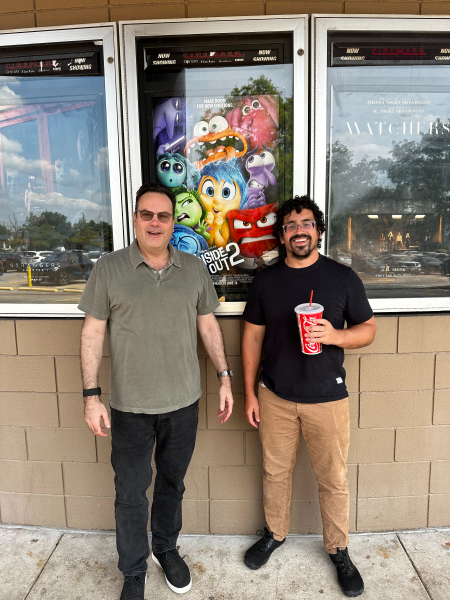My adult son took me to a Pixar movie and Dallas' version of NY Deli today for Father's Day.

Pixar movies never cease to amaze me. Whether you're a child, a teenager, or an adult, there's always something to enjoy and take away from them.
I especially enjoyed watching it next to my 31-year-old son and noticing that he responded emotionally to the same scenes I did. On one hand, it felt good to see what he processed and how he internalized things similar to the way I do. On the other hand, I thought, genetics is a bitch.
Jokes aside, having great kids is a double blessing. It's nice to be proud of who your kids are and the things they do. It's also nice to feel proud of the small part you played in helping them become who they are.
In addition, this weekend, I spent some time thinking about my father and what a terrific influence he had on so many lives.

My Dad was incredibly loving ... yet he was also incredibly demanding.
For example, after winning the State Championship in the shot put, I watched him run down from the stands. I figured he was coming down to celebrate. Instead, he looked deeply into my eyes and asked whether I was disappointed that I did not throw a personal best that day? I replied: "But Dad, I won." He smiled and recognized that winning was important too ... then he reminded me that the other throwers were not my real competition. To be and do your best, the competition is really with yourself ... and we both knew I could do better.
My Dad believed in setting high standards. He explained that most people's lives are defined by their minimum standards. Why? Because once those standards get met, it is easy to get distracted by other things and how to meet the minimum standards for them as well.
The point is to set a higher standard and to have a better life.
Here is another one of his favorite sayings. "The difference between good and great is infinitesimal." This applies to many things. For example, people who are good take advantage of opportunities; people who are great create them.
Here is something else worth sharing. "It's not over until we win!" This concept underscores the importance of resilience, commitment, and grit. My Dad emphasized that many people quit when they're on the brink of victory, simply because they don't realize how close they are.
This has led me to develop several practices. For example, if I pick up a book, I won't put it down until I finish a chapter. If I start a game, I can't stop until I exceed a specific score or level. And when I exercise, there's no way I'd ever stop before finishing a set.
Integrating these concepts involves aligning your head, heart, and feet. What I mean is that it's one thing to know the saying. It's another to make it a value or belief. And it's another thing altogether to make it a practice.
Well, that should explain a little of my dysfunction ... but, if you can't mess up your own kids, whose kids can you mess up?
Hopefully, you had a happy Father's Day weekend.
The Law (And Flaw) Of Averages
The law of averages is a principle that supposes most future events are likely to balance any past deviation from a presumed average.
Take, for example, flipping a coin. If you happen to get 5 "Heads" in a row, you'd most likely assume the next one should be "Tails" ... even though each flip has a 50/50 chance of landing on either.
Even from this example, you can tell it's a flawed law. While there are some reasonable mathematical uses of the law of averages, in everyday life, this "law" mostly represents wishful thinking.
It's also one of the most common fallacies succumbed to by gamblers and traders.
The concept of "Average" is more confusing and potentially damaging than you might suspect.
Perhaps you heard the story about how the U.S. Air Force discovered the 'flaw' of averages by creating cockpits based on complex mathematics surrounding the average height, width, arm length, etc., of over 4,000 pilots. Despite engineering the cockpit to precise specifications, pilots crashed their planes on a too-regular basis.
The reason? With hindsight, they learned that very few of those 4,000 pilots were actually "average". Ultimately, the Air Force re-engineered the cockpit and fixed the problem.
It's a good reminder that 'facts' can lie, and assumptions and interpretations are dangerous. It's why I prefer taking decisive action on something known, rather than taking tentative actions about something guessed.
via ReasonTV
Our Brains and the Illusion of Balance
Our brains are wired to find patterns, even in random events. This tendency, known as apophenia, can lead us to see connections where none exist.
The Misleading Law of Averages
It's this very tendency that fuels the misconception of the law of averages. We expect randomness to "even out" because we see patterns in short sequences. This can be tempting to believe, especially when dealing with chance events.
The law of averages is a common idea that suggests future events will even out past results to reach some average outcome. For instance, going back to our earlier coin-flipping example, after getting five heads in a row, it's natural to assume the next flip is "due" to be tails. However, that's not how probability works. Each coin flip is an independent event (with a 50% chance of landing on heads or tails), regardless of previous flips. The coin doesn't "remember" what happened before.
Apophenia isn't limited to coin flips. For instance, you might see your lucky number appearing repeatedly throughout the day, leading you to believe it has a special meaning – even though each instance is completely independent.
This natural desire for order and predictability can lead us astray when dealing with chance events.
Why is it Flawed?
The law of averages often leads to a misconception called the gambler's fallacy. This fallacy is the belief that random events can somehow "correct" themselves to reach an average. In reality, every coin flip, roll of the dice, or spin of the roulette wheel is a fresh start with its own discrete probabilities. The odds remain the same no matter how long the losing streak persists.
Are there ever times when it applies?
It's important to distinguish the law of averages from the law of large numbers, a well-established statistical principle. The law of large numbers states that as the number of random events increases, the average outcome gets closer to the expected probability. This applies in situations where many trials happen, and while past results of individual events are independent, the law describes the behavior of averages over a large number of trials. For instance, the average weight of a large sample of apples will likely be close to the expected average weight of an apple, even if some individual apples are heavier or lighter than expected.
However, in everyday situations (with a limited number of events), the law of averages is generally not a helpful way to think about chance or probabilities.
Understanding these misconceptions can help us make better decisions and avoid false expectations based on flawed reasoning.
Psychological Reasons Behind the Belief
Human decision-making suffers from a range of tendencies and biases.
Earlier, we discussed the tendency to find patterns, even where none exist. Next, we will consider cognitive bias. In our coin-flipping example, it is the representativeness heuristic that makes us assume that small samples should resemble the larger population they come from.
Emotional factors also play a role. The desire for control in uncertain situations can make us latch onto the law of averages as a comforting notion. Believing that things will "even out" gives us a sense of predictability and fairness in an otherwise random world.
Additionally, social influences can reinforce these beliefs. Stories and anecdotes about streaks ending or luck changing often circulate among friends and family, further embedding the misconception into our collective consciousness.
Understanding these psychological reasons helps explain why the law of averages persists despite its flaws. Recognizing these biases can empower us to think more critically about probability and chance events.
Improving Decision-Making in Gambling and Investing
Recognizing the fallacy of the law of averages can significantly enhance decision-making, particularly in gambling and investing. Understanding that each event is independent can help participants make more rational choices. Instead of chasing losses with the hope that a win is "due," savvy speculators understand their odds remain constant and may choose to walk away or set strict limits on their betting behavior.
In investing, this knowledge is equally crucial. Many factors influence markets. Nonetheless, believing that a stock "must" rebound after a series of declines too often leads to poor investment decisions. Investors who grasp that past performance does not dictate future results are better equipped to evaluate investments based on fundamentals rather than emotions or flawed expectations.
By dispelling these misconceptions, you can approach gambling or investing with a clearer mindset, reducing the risk of substantial losses driven by erroneous beliefs about probability and chance.
You can also eliminate fear, greed, and discretionary mistakes by relying on algorithms to calculate realtime expectancy scores and take the road less stupid. Take a different kind of chance. Just ask our AI Overlords; they'll tell you what to expect!
Posted at 06:25 PM in Business, Games, Ideas, Just for Fun, Market Commentary, Personal Development, Science, Sports, Trading, Trading Tools | Permalink | Comments (0)
Reblog (0)